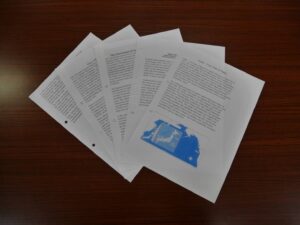Vol. 7 1/10/2021
Teacher’s Self Introduction
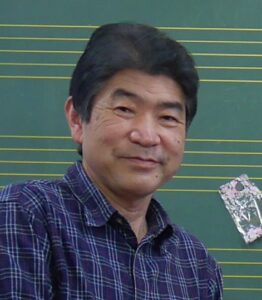
I'm Tadaharu Mukai, a member of the teaching staff. I'm mainly in charge of training the Kataribe Juniors to acquire the ability to guide and communicate in English about Mio's local history and sightseeing points.
English is a tool for communication. Although grammatical accuracy is necessary, gestures and paraphrasing can help compensate for grammatical shortcomings. The training includes activities such as games and presentations to practice communicating in English. It is said that language is acquired in a “spiral fashion” through the process of repeated use and correction of mistakes.
We will continue to help the juniors get used to using English while having fun. I'm looking forward to having many more experiences with Kataribe Juniors in the future.
Japanese ver. 語り部だより 第7号
Vol. 6 10/7/2021
Open Online Lecture Presentation
On June 13, Kataribe Juniors participated and presented in an open online lecture titled "Connected by emigrants VOL.5", which was held at the Canada Museum.
The theme of the lecture was the Asahi Baseball Association, the Japanese-Canadian baseball team.
Four juniors participated, and about 60 people from both Japan and overseas tuned in to join the lecture.
Yanagimoto, the leader of the Kataribe Juniors, explained how "Kataribe Project" started. Then the juniors introduced themselves. They introduced their activities, such as their usual classes, fieldworks, lectures by guest teachers, and exchanges with university students from Kyoto University of Foreign Studies that visited Mio for the first time, and the first time guiding for Japanese-American university students who visited Mio as a part of "the Kakehashi" Project.
At the end of the session, each student shared what they felt after learning about the Japanese-Canadian baseball team. “At first, Canadians discriminated against Japanese immigrants, but through baseball both sides gradually came to respect each other, and it was shocking to see how that was destroyed by the war.” “I was surprised to find out that there was such a deep relationship between Mio and Asahi, because I thought they had nothing to do with each other. And I was impressed by the member’s strong determination to win.” “I was really impressed by the team members, who continued to work hard with pride, and to be themselves despite of enduring discrimination and unpleasantness.” “After watching the film, I saw that the Japanese-Canadian were discriminated but they never gave up even though they lost many times in baseball games. If it were me, I would have definitely come back to Japan. I thought it was amazing that those people never gave up.”
The last few classes were used for the preparation of this presentation. The older juniors taught younger ones who were unfamiliar with computers and software. Even when club activity practice prevented them from participating, the juniors worked together to prepare.
The juniors have grown a lot through their work and participation in this presentation.
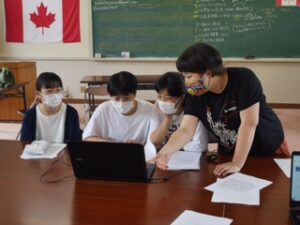
Working together to create presentation documents.
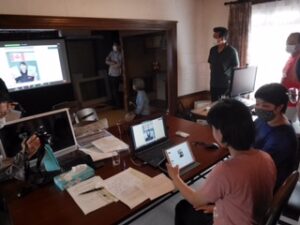
Juniors make their presentation.
Teacher's Self Introduction
 Hello there! I'm Mihori Ueyama and I teach English at Kataribe classes.
Hello there! I'm Mihori Ueyama and I teach English at Kataribe classes.
I grew up in Mihama Town. I was fortunated enough to be involved in Kataribe Projects when I was an English teacher at my old school, Shoyo Junior High School.
Since I was a child, I had had a strong longing to go abroad and a desire to learn foreign languages. I feel that the experience of participating in the Canada Exchange Program in Mihama town and tracing the history of the emigrant with my own eyes has made me what I am today.
Through Kataribe activities, I have learned a lot with thinking about “the courage to face an unknown future" and "the power of action" of Gihei Kuno, the man who left Mio in Mihama Town for the foreign lands, building a life and a community of Japanese immigrants in Vancouver more than 130 years ago. I'm looking forward to having more experiences with Kataribe juniors.
Japanese ver. 語り部だより 第6号
Vol. 5 10/5/2021
Exchange with Students from the Kyoto University of Foreign Studies
On March 21, ten students from the Department of Global Tourism at Kyoto University of Foreign Studies, who had been staying in Mio for two weeks as a part of their Community Engagement Program, came to our class to interact with us.
In the first half, after each student introduced themselves, the juniors introduced famous places in Mio on the presentation slides.
In the second half, students divided into four groups and had a chance to talk directly with the university students. The juniors asked: “Why did you choose the Department of Global Tourism?” “What do you learn on that course, and what kind of work would you like to do in the future?” After the exchange, one of the juniors said, “I heard about the goals that the students have in the Department of Global Tourism, and it is really nice to have a dream. I have a dream too, so I’m going to work hard to achieve it.”
Mr. Masanobu Mio, the Kataribe teacher, said, "I could see that they have grown up as "Kataribe" with having various experience. In addition, I believe that dialogue with people from different regions and ages, with whom the juniors do not normally interact, has broadened their ways of thinking."
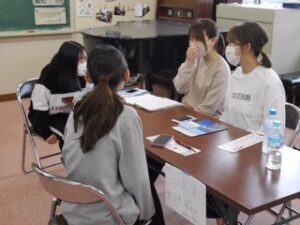
They get very excited with their common hobbies.
Teacher's Self Introduction
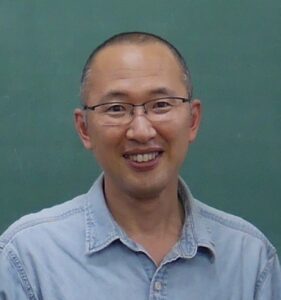 My name is Masanobu Mio and I teach history.
My name is Masanobu Mio and I teach history.
I grew up in Mio until I graduated from high school, and after working outside of Wakayama Prefecture for 28 years, I came back to Mihama town four years ago.
I no longer have my house in Mio, so I now live in Wada.
Shortly after I came back, I walked around Mio with nostalgia. As I gazed at the empty houses that looked as if they were about to collapse, I felt a sense of loneliness in my heart. Unlike my childhood, I felt that Mio had lost its liveliness.
I wanted to do something, but I was not confident that I could do much by myself. Then I was asked to join "Kataribe Project" as a history teacher by Mr. Yoshikawa, a Kataribe teacher.
I decided to start with things that I can do. I'm looking forward to having many experiences with Kataribe juniors.
Japanese ver. 語り部だより 第5号
Vol. 4 25/3/2021
Socializing at the Canadian Museum Virtual Tour
The first class in January was an online Canadian Museum Tour connecting Mio and Canada.
It was a grand event where various people from Japan and abroad who are connected by the word “Canadian emigrants” were able to come together using Zoom. In the midst of this event, the Kataribe Juniors were given a 15-minute slot to present their activities in English.
The idea of online exchange itself is new, and suddenly they had to give a presentation in English on a large stage with the world watching. Despite my worries that they would be very nervous, the juniors proudly introduced Mio and told the people on the other side of the screen about their activities on a daily basis.
On the other side of the screen, there were a lot of people who we don’t get to meet in our daily lives, such as professors who are studying immigration at universities in Japan and Canada, the director of the Nikkei National Museum & Cultural Centre, and third and fourth generation Japanese Americans who have their roots in Mio.
It was a wonderful opportunity for the younger generation to learn about the history of emigrants and to connect with people who are working hard to preserve it.

Commemorative photo with the participants 10.1.2021
Translating the Original Asahi Baseball Team Story
The juniors are now translating the English text about the history of the Asahi Baseball Team into Japanese.
The Asahi Baseball Association (formerly known as the Canadian Nikkei Youth Baseball Club was formed to carry on the work of the pre-war Asahi Baseball Team, which was very successful in Vancouver, and to provide an opportunity for the younger generation to interact with a variety of people through baseball.
Mr. Sammy Takahashi, President of the Japan-Canada Chamber of Commerce and Industry and one of the founders of the Asahi Baseball Association, connected with the first group of students during their visit to Canada the year before last.
The completed translation will be posted on the Asahi Baseball website. It is a difficult task for junior high school students. However, I feel that through the process of gradually translating a story while looking up unfamiliar words in a dictionary and on the Internet, they are not only experiencing the work of translation, but also creating a new bond between Japan and Canada.
I am looking forward to our next trip to Japan, where we can interact with each other in Mio.
The English manuscript on which the translation was based.
Japanese ver. 語り部だより 第4号
Vol. 3 10/2/2021
Fieldwork at Komyoji Temple
On October 25, the group visited Komyoji Temple.
Mr. Terunobu Miwa, the head priest at Komyoji, gave us a brief history of the temple and showed us around the main hall.
The temple, part of the Jodo Shin sect of Buddhism, was founded 450 years ago in 1563 by Dogan, a Buddhist priest who wanted to established a place for Buddhist meditation in the Bo Valley.
The priest explained to us that: “The main hall is made of zelkova, a high-grade wood. When the main hall was built in 1930, we received a lot of donations from people who had been to Canada to fund the construction. At that time, the amount donated was about 55,000 yen. In today's money, it would be about 250 million yen, some 4500 times the value.” I was surprised to hear this explanation.
The phoenix painting on the plaster wall was damaged by a typhoon the year before last, and the restoration was done by Yoshitaka Nishigaki, a painter from Yoshihara, a district in Gobo City.
During our visit, we were allowed into the inner sanctum to view the main statue of Amida Nyorai, which is also a cultural asset. This is usually only accessible to monks.
One junior said, “I was told that the inner sanctum represents the Pure Land of Ultimate Bliss, and it is not often that you get to go in there, so it was a valuable experience for me. I think opportunities to enter such a place are quite rare.”

Getting an explanation of the donation card.
Teacher's Self Introduction
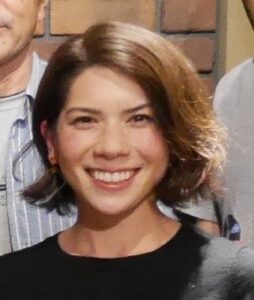 My name is Kelly McLachlan and I am a Mihama Town ALT.
My name is Kelly McLachlan and I am a Mihama Town ALT.
I came to Mihama from Vancouver, Canada two summers ago to teach English at the elementary and junior high schools in the town. Living in Japan has been one of the best experiences of my life. I have visited so many beautiful places, experienced so much culture and food, and met so many wonderful people.
One of the things that has made my life more meaningful is my work with Kataribe Juniors in Mio. I have been greatly influenced by the Kataribe Juniors staff and the juniors themselves, who are so passionate about learning about the history of Canada and Mio.
Learning about Canadian emigrants, who are my ancestors and my family's roots, has been a very moving experience for me. I feel very fortunate to be able to be involved in storytelling and to be able to explore my roots in Mio.
I will be returning to Canada soon. However, I would like to continue to be involved in the activities of Kataribe Juniors even after I return to Canada. I hope that Canada and Japan will continue to interact with each other for a long time to come.
Japanese ver. 語り部だより 第3号

